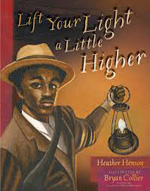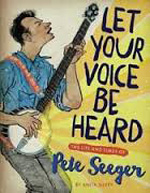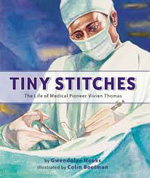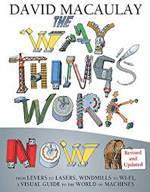So many great books, both nonfiction and fiction, can be used to include literature across curriculum development. Teachers can read aloud books in different genres to introduce a topic. They can combine multiple books to create text sets that supplement and enrich instruction as well as add new books to update established classroom text sets. Trade books provide sources for research, and their content inspires conversation on critical topics. The recently published books in this column serve interests in multiple content areas.
Ages 4–8
Around America to Win the Vote: Two Suffragists, a Kitten, and 10,000 Miles. Mara Rockliff. Ill. Hadley Hooper. 2016. Candlewick.
 In 1916, in a little yellow car, Neil Richardson and Alice Burke took a trip around the country. Their goal: “Votes for Women!” Traveling from New York City to Philadelphia and then south before heading west to California and returning to New York via a northern route, the two adventuresome women made speeches to rally support for women’s suffrage. Rockliff’s text is as energetic as the two suffragists who made the 10,000-mile journey, and Hooper’s illustrations, done in pencil and printmaking techniques, then scanned and completed digitally, complement the spirited text. Back matter includes extensive notes on both “the newfangled machine”—a Saxon Motor Car that drew as much attention as Richardson and Burke—and the Suffragists Movement, a note on sources, primarily newspaper reports, and books for further reading.
In 1916, in a little yellow car, Neil Richardson and Alice Burke took a trip around the country. Their goal: “Votes for Women!” Traveling from New York City to Philadelphia and then south before heading west to California and returning to New York via a northern route, the two adventuresome women made speeches to rally support for women’s suffrage. Rockliff’s text is as energetic as the two suffragists who made the 10,000-mile journey, and Hooper’s illustrations, done in pencil and printmaking techniques, then scanned and completed digitally, complement the spirited text. Back matter includes extensive notes on both “the newfangled machine”—a Saxon Motor Car that drew as much attention as Richardson and Burke—and the Suffragists Movement, a note on sources, primarily newspaper reports, and books for further reading.
—CA
Circle. Jeannie Baker. 2016. Candlewick.
 Bar-tailed godwits, shore birds that live in New Zealand and Australia and nest in Alaska, migrate more than 10,000 miles each year. On their way north to Alaska, they stop to recuperate and feed in the wetlands of Asia, but they fly nonstop on their return journey. Illustrating the book with structured collage of paper, paint, and plant matter, Baker describes the godwits’ behavior and the habitats along their route north, habitats that are shrinking because of development and urbanization. Back matter includes a map of the godwits’ migratory route and an author’s note explaining that the annual movements of birds, sea creatures, and other animals are a reminder that everything on the planet is connected and interdependent.
Bar-tailed godwits, shore birds that live in New Zealand and Australia and nest in Alaska, migrate more than 10,000 miles each year. On their way north to Alaska, they stop to recuperate and feed in the wetlands of Asia, but they fly nonstop on their return journey. Illustrating the book with structured collage of paper, paint, and plant matter, Baker describes the godwits’ behavior and the habitats along their route north, habitats that are shrinking because of development and urbanization. Back matter includes a map of the godwits’ migratory route and an author’s note explaining that the annual movements of birds, sea creatures, and other animals are a reminder that everything on the planet is connected and interdependent.
—SW
Clara: The (Mostly) True Story of the Rhinoceros Who Dazzled Kings, Inspired Artists, and Won the Hearts of Everyone . . . While She Ate Her Way Up and Down a Continent! Emily Arnold McCully. 2016. Schwartz & Wade/Random House.
 Born in Assam sometime around 1740 and orphaned, the rhinoceros Clara was adopted by a director of the Dutch East India Company, who knew she could not survive without her mother. She lived in his house as a pampered pet. On a visit with the family, a Dutch sea captain offered to purchase Clara and take her to Europe to teach people about rhinoceroses, which many people thought were mythical beasts. In bright watercolor illustrations McCully depicts the years Clara spent delighting and mystifying people, including the aristocracy, all the while being fed tons of vegetables and fruits. A map of Clara’s travels appears on the endpapers. In the back matter, McCully provides information on the global habitats of rhinoceroses then and now, including a reference to issues related to contemporary beliefs about the humane treatment of wild animals.
Born in Assam sometime around 1740 and orphaned, the rhinoceros Clara was adopted by a director of the Dutch East India Company, who knew she could not survive without her mother. She lived in his house as a pampered pet. On a visit with the family, a Dutch sea captain offered to purchase Clara and take her to Europe to teach people about rhinoceroses, which many people thought were mythical beasts. In bright watercolor illustrations McCully depicts the years Clara spent delighting and mystifying people, including the aristocracy, all the while being fed tons of vegetables and fruits. A map of Clara’s travels appears on the endpapers. In the back matter, McCully provides information on the global habitats of rhinoceroses then and now, including a reference to issues related to contemporary beliefs about the humane treatment of wild animals.
—SW
Green City: How One Community Survived a Tornado and Rebuilt for a Sustainable Future. Allan Drummond. 2016. Frances Foster/Farrar Straus Giroux.
 After Greenburg, a town in central Kansas, was leveled by a tornado in 2007, the residents decided to rebuild differently, working together to incorporate modern ideas in design and construction to create a sustainable community. An unnamed narrator (the boy in a red jacket and wearing a green cap in the illustrations) recounts the effort of transforming a scene of devastation into a vibrant community. With illustrations rendered in watercolor and ink, Drummond chronicles events and shows that the project was not without setbacks as residents became discouraged with the hardships of their transitional lives. Sidebars provide information about specific aspects of the town’s rebuilding for a sustainable future, and the back matter includes an author’s note, sources, and tips for going green.
After Greenburg, a town in central Kansas, was leveled by a tornado in 2007, the residents decided to rebuild differently, working together to incorporate modern ideas in design and construction to create a sustainable community. An unnamed narrator (the boy in a red jacket and wearing a green cap in the illustrations) recounts the effort of transforming a scene of devastation into a vibrant community. With illustrations rendered in watercolor and ink, Drummond chronicles events and shows that the project was not without setbacks as residents became discouraged with the hardships of their transitional lives. Sidebars provide information about specific aspects of the town’s rebuilding for a sustainable future, and the back matter includes an author’s note, sources, and tips for going green.
—SW
Lift Your Light a Little Higher: The Story of Stephen Bishop: Slave-Explorer. Heather Henson. Ill. Bryan Collier. 2016. Caitlin Dlouhy/Atheneum/Simon & Schuster.
 “Down here, I am Guide—a man able to walk before other men, not behind…. A man—down here, that’s what I am—a man not just a slave.” Through a first person narrative, Henson has Stephen Bishop, who became the best-known guide of Mammoth Cave in Kentucky from around 1838 to 1857, tell his own story. Bishop reveals his pride in his discoveries and knowledge of the cave and his ability to lead tourists safely through its dark passages. With numerous close-up portraits against a background of the dark cave interior, Collier’s stunning double-spread illustrations, rendered in watercolor and collage, keep the focus on Bishop. Back matter includes author and illustrator notes that provide an historical context for this picture-book biography and other resources.
“Down here, I am Guide—a man able to walk before other men, not behind…. A man—down here, that’s what I am—a man not just a slave.” Through a first person narrative, Henson has Stephen Bishop, who became the best-known guide of Mammoth Cave in Kentucky from around 1838 to 1857, tell his own story. Bishop reveals his pride in his discoveries and knowledge of the cave and his ability to lead tourists safely through its dark passages. With numerous close-up portraits against a background of the dark cave interior, Collier’s stunning double-spread illustrations, rendered in watercolor and collage, keep the focus on Bishop. Back matter includes author and illustrator notes that provide an historical context for this picture-book biography and other resources.
—CA
Ages 9–11
Grover Cleveland, Again! A Treasury of American Presidents. Ken Burns. Ill. Gerald Kelley. 2016. Alfred A. Knopf/Random House.
 This collective biography is an engaging introduction to the 43 men who have served as president of the United States. Each is given a double spread (Grover Cleveland gets two as the 22nd and 24th president) of text and a pencil-and-digitally colored illustration highlighting accomplishments and important events during his years in office. In addition, there is a quotation (two for Cleveland: “Whatever you do, tell the truth” and “What is the use of being elected or re-elected unless you stand for something”) and a sidebar with the president’s official portrait and biographical data, including interest-catching entries such as Nicknames (for Cleveland, “Veto President,” or “President Who Said “No!” because of his numerous uses of the president’s veto power) and Pets (for Cleveland, dogs of many breeds among other pets). Back matter includes a list of presidential birthplaces, libraries, museums, and historical sites as well as a glossary.
This collective biography is an engaging introduction to the 43 men who have served as president of the United States. Each is given a double spread (Grover Cleveland gets two as the 22nd and 24th president) of text and a pencil-and-digitally colored illustration highlighting accomplishments and important events during his years in office. In addition, there is a quotation (two for Cleveland: “Whatever you do, tell the truth” and “What is the use of being elected or re-elected unless you stand for something”) and a sidebar with the president’s official portrait and biographical data, including interest-catching entries such as Nicknames (for Cleveland, “Veto President,” or “President Who Said “No!” because of his numerous uses of the president’s veto power) and Pets (for Cleveland, dogs of many breeds among other pets). Back matter includes a list of presidential birthplaces, libraries, museums, and historical sites as well as a glossary.
—CA
Let Your Voice Be Heard: The Life and Times of Pete Seeger. Anita Silvey. 2016. Houghton Mifflin Harcourt.
 Born into a family of musicians, Pete Seeger was influenced by his father’s growing sympathy for the lives and efforts of working-class people, but the greater influence followed the divorce of his parents in 1927, when he was 8 years old. Schooled in private schools in New England, Seeger discovered a love of music, and, through employment in the Library of Congress, he discovered the history of American music. His many musical mentors were figures in American musical history, including Alan Lomax, Lead Belly, and Woody Guthrie. They influenced his focus on social justice and the conservation of what he called the people’s music. Illustrating the book with archival photographs, Silvey traces American culture and politics through Seeger’s performances. Silvey includes a chapter on Seeger’s legacy, extensive source notes, and an afterward.
Born into a family of musicians, Pete Seeger was influenced by his father’s growing sympathy for the lives and efforts of working-class people, but the greater influence followed the divorce of his parents in 1927, when he was 8 years old. Schooled in private schools in New England, Seeger discovered a love of music, and, through employment in the Library of Congress, he discovered the history of American music. His many musical mentors were figures in American musical history, including Alan Lomax, Lead Belly, and Woody Guthrie. They influenced his focus on social justice and the conservation of what he called the people’s music. Illustrating the book with archival photographs, Silvey traces American culture and politics through Seeger’s performances. Silvey includes a chapter on Seeger’s legacy, extensive source notes, and an afterward.
—SW
Tiny Stitches: The Life of Medical Pioneer Vivien Thomas. Gwendolyn Hooks. Ill. Colin Bootman. 2016. Lee & Low.
 The pioneering research that led to the first successful “blue-baby” surgery in 1941 went unacknowledged for three decades. Hooks recounts the life and work of Vivien Thomas, the medical assistant who developed the surgical procedure that saves the lives of babies whose hearts did not function to get oxygenated blood pumping through the body. As a boy,
The pioneering research that led to the first successful “blue-baby” surgery in 1941 went unacknowledged for three decades. Hooks recounts the life and work of Vivien Thomas, the medical assistant who developed the surgical procedure that saves the lives of babies whose hearts did not function to get oxygenated blood pumping through the body. As a boy,
Thomas longed to be a doctor; however, he was unable to attend medical school so he took a job as assistant to Dr. Alfred Blalock. Thomas began his years of systematic, dedicated research into the surgery on infants at which many doctors scoffed. The double-spread watercolor illustrations of this picture-book biography depict Thomas’s development of the procedure and equipment needed to perform it. Back matter includes additional information on Thomas and the surgical procedure he developed, a glossary, and author’s sources. For additional reading on Thomas, check out Jim Murphy’s Breakthrough: How Three People Saved “Blue Babies” and Changed Medicine Forever (2015), which is a multi-chapter book with archival photographs that show Thomas’s life and work.
—SW
Ages 12–14
Nine, Ten: A September 11 Story. Nora Raleigh Baskin. 2016. Atheneum/Simon & Schuster.
 Two days in the lives of four middle-school students in different parts of the United States unfold hour by hour revealing their hopes, challenges, and the consequences of choices they make. Math genius Sergio, living in Brooklyn, NY, with his grandmother, is befriended by a fireman when he skips school one day. Aimee lives in Los Angeles, CA, and is sure her parents are considering a divorce when her mother goes to New York City for a business position. Will, who lives in Shanksville, PA, wrestles with the death of his father, a truck driver, who died while trying to help a distressed driver along the highway. Naheed, of Columbus, OH, honors her Muslim heritage and culture and, in her efforts to make friends, feels encumbered by the friendly overtures of Eliza, a class outcast. The attacks of 9/11 affect each character as they forge friendships and resolve the challenges they face. Baskins includes an author’s note with additional information about writing this book.
Two days in the lives of four middle-school students in different parts of the United States unfold hour by hour revealing their hopes, challenges, and the consequences of choices they make. Math genius Sergio, living in Brooklyn, NY, with his grandmother, is befriended by a fireman when he skips school one day. Aimee lives in Los Angeles, CA, and is sure her parents are considering a divorce when her mother goes to New York City for a business position. Will, who lives in Shanksville, PA, wrestles with the death of his father, a truck driver, who died while trying to help a distressed driver along the highway. Naheed, of Columbus, OH, honors her Muslim heritage and culture and, in her efforts to make friends, feels encumbered by the friendly overtures of Eliza, a class outcast. The attacks of 9/11 affect each character as they forge friendships and resolve the challenges they face. Baskins includes an author’s note with additional information about writing this book.
—SW
The Way Things Work Now: From Levers to Lasers, Windmills to Wi-Fi, a Visual Guide to the World of Machines. David Macaulay (with Neil Ardley). 2016. Houghton Mifflin Harcourt.
 This new and expanded 2016 edition of Macaulay’s “visual guide to the world of machines,” which began with The Way Things Work (1988), continues to offer readers an accessible and engaging introduction to machines, organized by the scientific principles behind them. Most of the prior content and examples have not changed, retaining the volume’s importance as a guide on how one invention builds upon earlier ones. The greatest changes occur in the “Digital Domain” section. Brighter coloring of illustrations, which still humorously involve woolly mammoths, makes delving into details inviting. Macaulay’s text is informative, but it is his diagrams and cutaways providing explanations of how things work—from zippers to satellite navigation systems—that will sustain the interest of readers of all ages. Back matter includes a 16-page “Eureka!” section of inventions, a glossary of technical terms, and an index.
This new and expanded 2016 edition of Macaulay’s “visual guide to the world of machines,” which began with The Way Things Work (1988), continues to offer readers an accessible and engaging introduction to machines, organized by the scientific principles behind them. Most of the prior content and examples have not changed, retaining the volume’s importance as a guide on how one invention builds upon earlier ones. The greatest changes occur in the “Digital Domain” section. Brighter coloring of illustrations, which still humorously involve woolly mammoths, makes delving into details inviting. Macaulay’s text is informative, but it is his diagrams and cutaways providing explanations of how things work—from zippers to satellite navigation systems—that will sustain the interest of readers of all ages. Back matter includes a 16-page “Eureka!” section of inventions, a glossary of technical terms, and an index.
—CA
Ages 15+
Bubonic Panic: When Plague Invaded America. Gail Jarrow. 2016. Calkins Creek/Highlights.
 Even though the bubonic plague ravaged countries through three separate pandemics across a span of almost 2,000 years, the plague remained terrifying mysteries to the people who suffered from it. The first pandemic, in what is now Turkey, began in the 8th century. The second one, which swept through Europe, began in the 14th century and lasted into the 18th century. The third pandemic first appeared on American shores in San Francisco in 1894. Through the 19th century, doctors and scientists investigated the plague’s sources and how it was transmitted. Even after two scientists independently determined that the plague bacterium was transmitted by a particular flea, civic officials around the world spent less time focusing on the fleas and the rat that carried them than on quarantining people in communities where plague was found. Jarrow includes a final chapter reporting on present-day evidence of the bubonic plague in the United States. Archival and color photographs supplement the text. Back matter includes frequently asked questions, a glossary, extensive source notes, a bibliography, and a timeline.
Even though the bubonic plague ravaged countries through three separate pandemics across a span of almost 2,000 years, the plague remained terrifying mysteries to the people who suffered from it. The first pandemic, in what is now Turkey, began in the 8th century. The second one, which swept through Europe, began in the 14th century and lasted into the 18th century. The third pandemic first appeared on American shores in San Francisco in 1894. Through the 19th century, doctors and scientists investigated the plague’s sources and how it was transmitted. Even after two scientists independently determined that the plague bacterium was transmitted by a particular flea, civic officials around the world spent less time focusing on the fleas and the rat that carried them than on quarantining people in communities where plague was found. Jarrow includes a final chapter reporting on present-day evidence of the bubonic plague in the United States. Archival and color photographs supplement the text. Back matter includes frequently asked questions, a glossary, extensive source notes, a bibliography, and a timeline.
—SW
Sandip Wilson serves as associate professor in the College of Health and Education of Husson University in Bangor, ME. Carolyn Angus is former Director of the George G. Stone Center for Children's Books, Claremont Graduate University, CA.
These reviews are submitted by members of the International Literacy Association's Children's Literature and Reading Special Interest Group (CL/R SIG) and are published weekly on Literacy Daily.